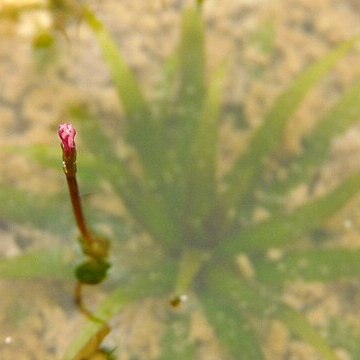Submerged stoloniferous plants, monoecious or dioecious. Leaves linear, spirally arranged, radical or along a 15-60 cm long stem, base sheathing or semi-amplexicaulous, margin minutely dentate, apex attenuate; nerves parallel, midrib prominent. Spathe sessile or peduncled, tubular, with 6 longitudinal ribs, bifid at the tip, 1-flowered, or in male spathes of dioecious plants with up to 10 flowers. Peduncle flattened or terete in cross-section, with a nod close under the spathe. Flowers unisexual or bisexual, female and bisexual ones sessile, male ones pedicelled. Sepals 3, linear or linear-lanceolate, green, persistent. Petals 3, linear, longer than the sepals, white, flaccid, fringed. Stamens 3, 6 or 9; filaments capillary; anthers linear or lanceolate, bilocular, latrorsely dehiscent. Ovary linear, with a long, filiform rostrum, inside with 3 parietal placentas; styles 3, linear, connate at the base. Fruit linear or linear-lanceolate; wall membranous. Seeds 10-∞, elliptic or fusiform, 1-2 mm; testa glabrous or with 3-8 longitudinal rows of more or less conspicuous tubercles or spines.
Plants annual [perennial], of fresh waters. Rhizomes absent [present]; stolons present. Erect stems rooted in substrate, unbranched short. Leaves basal, submersed, sessile; blade of uniform color from margin to margin, with continuous intercellular spaces, linear, base grading into sheath, apex acute; midvein without rows of lacunae along sides, uniform in color throughout from margin to margin, with continuous intercellular spaces; abaxial surfacely without prickles or aerenchyma; intravaginal squamules entire. Inflorescences 1-flowered, flowers rarely paired [cymose], long-pedunculate; spathe not winged. Flowers bisexual [unisexual, staminate and pistillate on different plants], emersed, pedicellate; petals white to reddish; filaments distinct; anthers fusiform; pollen in monads; ovary 1-locular; styles 1, not 2-fid. Fruits cylindric, ridged, dehiscing irregularly. Seeds ellipsoid or fusiform, echinate [without spines and with or without ridges or wings].
Herbs, submerged freshwater. Stems short or elongated, erect or stoloniferous. Leaves basal or spirally arranged along stem, sessile, lanceolate or linear, with prominent midvein and several lateral veins, sheathed at base, minutely serrulate along margin. Spathe tubular, sessile or pedunculate, bifid at apex, with longitudinal veins, 1-flowered or sometimes several flowered. Flowers bisexual or unisexual. Sepals 3, persistent, green, linear or lanceolate. Petals 3, white, longer than sepals. Stamens 3-9; filaments slender; anthers 4-thecous. Pistils 3; ovary linear, attenuate into a long, filiform beak; styles 3; ovules numerous. Fruit linear to terete, long, narrow. Seeds numerous, oblong-fusiform, smooth or with spines, sometimes with a filiform projection from each end.
Freshwater, monoecious, dioecious or flowers bisexual, annual or perennial, attached, tufted (in Australia). Leaves submerged; blade linear, tapered, with prominent midrib and numerous fine cross veins; margins minutely serrulate. Inflorescence emergent. Male flowers conspicuous, pedicellate. Female and bisexual flowers sessile in spathe; spathe sessile or pedunculate, tubular, bifid at tip. Outer perianth segments persistent, 3, linear or linear-lanceolate. Inner perianth segments 3, linear, longer than outer ones, white, fringed. Stamens 3–9. Staminodes present, minute in female flowers. Ovary linear, unilocular with 3 parietal placentas, longstyled within slender hypanthium; stigmas 3, linear, entire. Fruit linear, enclosed in spathe. Seeds 10–many, ellipsoid to ovoid.

